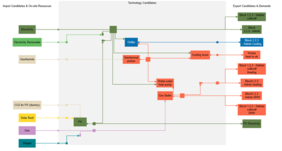
Joint planning of city districts to achieve climate goals
To master the energy transition, cities around the world are forced to act and propose innovative net-zero strategies for their territories. In Switzerland, net zero is to be achieved by 2050, and Yverdon-les-Bains is in the process of rethinking its energy system. In a partnership with parties eicher+pauli, Sympheny and enersis, Yverdon-les-Bains Energies is at the center of developing a proof of concept that shows how urban energy planning can be digitized for data-driven, informed decision-making.
Optimal use of all available resources
The "Gare-Lac" site under consideration is expected to have a built-up area of about 193,000 m2 in 2040.
The presence of a wastewater treatment plant as a source of low temperature heat is already used in some buildings. The existing local master plan calls for the expansion of this low-temperature network as well as the creation of a high-temperature network supplied by a central heat plan
Reducing emissions by 83% by 2040 thanks to Sympheny.
This initial analysis shows promising results. Even if the CO2-optimal solutions do not reach net zero, this shows the potential and opportunities to drastically reduce CO2 emissions through the renovation of old buildings, the use of technologies such as heat pumps and techniques such as heat recovery. In addition, joined-up thinking is required. As the analysis has shown, the anergy network provided by wastewater treatment is the key to optimized energy concepts.
An operational CO2 emission reduction of 83% is achieved between the status quo and the CO2 optimal solution of 2040. The use of Sympheny's optimization algorithms ensures that the optimal solution considered has the corresponding lowest life cycle cost.
Identify concrete steps for goal-oriented projects
Sympheny's intuitive WebApp also enabled the development of a comprehensive analysis for a complex site in a short time. In a next step, the project team recommends deepening some aspects of the analysis. The model created in Sympheny can be seamlessly adapted to accommodate these steps. The issues are as follows:
- Consider borehole heat exchangers not only as a source of heating energy, but also as an energy sink/storage for (free) cooling or waste heat storage.
- Sizing battery storage to maximize PV self-consumption.
- Refinement of the boundary conditions for the grids
- Analyze energy savings potential for retrofits of existing buildings.
- The results make it possible to quantify what CO2 reduction is possible at what cost. In this case, three strategy levels are considered.